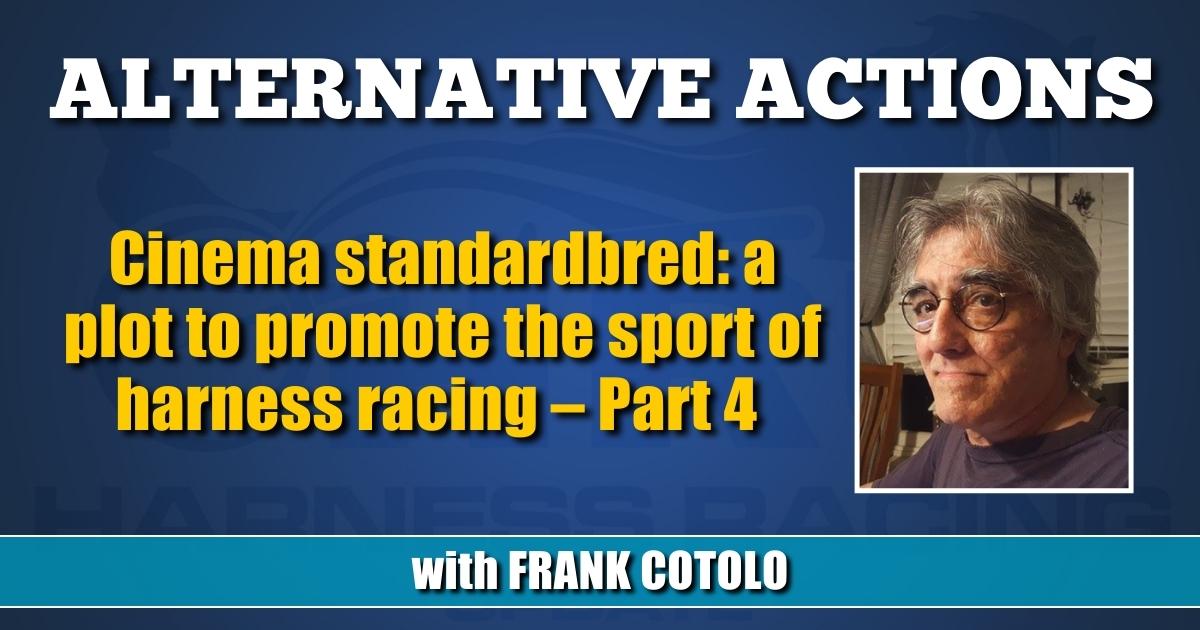Cinema standardbred: a plot to promote the sport of harness racing – Part 4
by Frank Cotolo
Alternative Actions (AA) continues its series developed to offer the solution that has the best chance to change the nature of the film industry’s ambivalence towards harness racing and perhaps inspire someone to pioneer a project that could be the most successful promotional tool standardbred racing ever utilized.
Part 1 is here.
Part 2 is here.
Part 3 is here.
The standardbred-screenplay predicament can be solved. First, a short primer to explain and accept the initial problem.
In parts 1 through 3 of this series I did not mention the most recent and somewhat successful Hollywood films having to do with horse racing for a reason. “Phar Lap” (1983), “Seabiscuit” (2003) and “Secretariat” (2010) idolized three extraordinary thoroughbreds of the 20th century, vis a vis, their titles. Yet, none of them were truly biographies of the equine heroes; that would have been better served in documentary style. All three are based upon real horses, people and events — to a degree. Non-fiction — mostly. For now, forget about the process of adaptation. We will use that gimmick later; let’s look at the guts of the movies’ three stories.
Moreso than in any Hollywood film so much as flirting with horse racing, the screenplays of those three motion pictures appealed to audiences, whether the audiences were horse racing fans or not, because of their human characters.
“Well-defined characters,” wrote Lajos Egri, author of The Art of Dramatic Writing, “will drive the plot themselves; the foundation of character is the essential germination of a well-crafted story.”
David Williamson’s screenplay follows the rise and fall of Phar Lap’s trainer, Tommy Woodcock, a run-of-the-mill, fading, veteran dreaming of greatness. He gets Phar Lap by chance and it turns out the horse is phenomenal.
Based on the success of Phar Lap, Woodcock becomes rich and famous. But when he greatly expands his stable it is obvious his skills have nothing to do with Phar Lap’s extraordinary talent. Tommy pushes Phar Lap hard so as to support his training career while powerful business figures feel Phar Lap’s success is toxic to their greedy interests.
In the end of the story (which happens to be the opening scene), the steed mysteriously drops dead from poisoning. Tommy is ruined but satisfies the character’s journey, which stresses the story’s premise: “hubris leads to ruin.”
Dramatic truth results when the main character changes (greatly or subtly), confirms the premise and delivers “the ever-present role of change in all forms of life, forcing people to evolve in the face of one overwhelming obstacle after another.”
“Seabiscuit” is the name of the underdog steed but the movie is a story driven by three human characters. His owner (Charles Howard), his trainer (Tom Smith) and his jockey (Red Pollard) team up to prove the premise “courage leads to hope.”
More than Seabiscuit’s racing history, which the three men work heart and soul to inspire, the story succeeds because they defy the spirit-crushing weight of the Great Depression and become stronger against all odds, so to speak. The audience identified with characters personified by their horse.
Roger Ebert wrote, “If an underdog like Seabiscuit could win against larger and more famous horses with distinguished pedigrees, then maybe there was a chance for anyone.”
The premise of “Secretariat” was similar, except Secretariat is unlike Seabiscuit; Secretariat is born of royal blood; he’s a superior steed. It’s the characters in this story that must rise to a level that changes them for the better.
“The owner (Penny Chenery) and trainer (Lucien Laurin) are characters who are vivid, human and complex” (Ebert again). The story also promotes courage in the face of strong opposition from tradition. Chenery is a woman with a mission, facing hard-boiled habits of horsemen who dismiss her as a serious player in the business. Laurin is on the brink of retirement and anonymity. The natural brilliance of their thoroughbred allows them to find special talents in themselves that are deserving of Secretariat’s god-like persona.
WRITE FROM WRONG
There is a good reason Hollywood’s harness-racing snub has lasted through the history of movies and it is nothing personal. The standardbred-screenplay predicament, as the history we covered explains, reveals there has never been a screenplay written bound to dramatic truth driven by “characters who are vivid, human and complex.”
Every attempt I have read at a screenplay involving a major standardbred or the sport in general has been about a horse and the sport. That is the problem.
A writer I knew in the ‘70s wrote a script with a Baseball theme. When rejected, he blamed it on producers disliking baseball. Years later, the success of “Field of Dreams” angered him. I said his script failed because it is about baseball; “Field of Dreams” is not.
In part 5 I’ll hand you the keys to the library of writing tools that always work in scripts and the encyclopedia of premises at a screen writer’s disposal.

















